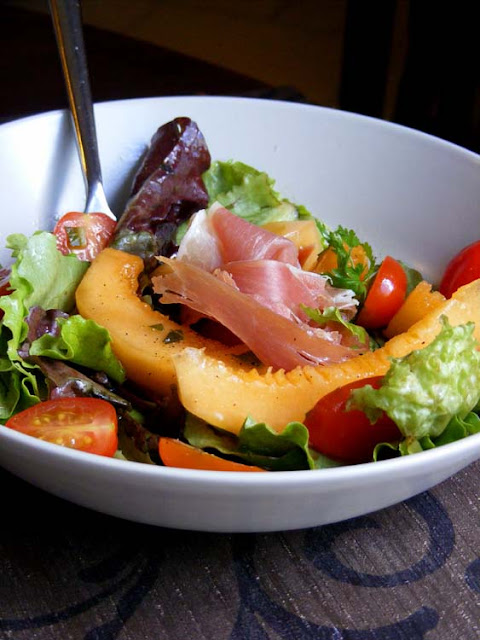...and other top tips for discerning the ripeness of that iconic local fruit, the Charentais melon.
 |
| Charentais melon, cut in half. |
Some people press the stem or the flower end to see if they give a bit. Some people get up close and personal to smell them. They should be fragrantly melon scented, not boozy smelling (a sign of over-ripeness and fermenting). Others tap them to see if they make the right hollow sound, and a few heft them in their hand to check they are heavy for their size. A widely held belief is that the best melons have exactly 10 ribs and some people won't buy melons with fewer or more than this.
 |
| Melons marked by the producer in the order we should eat them. |
Be careful though, touching the melons is often frowned upon by the market traders, and it can be a sure way of indicating that you are a tourist if you pick up a melon without asking first. It's OK to pick up a melon in the supermarket though.
 |
| Melons at Preuilly market, sold by the local producer. |
Personally, I ask the melon seller to choose me one. They will normally ask when I want to eat it and choose one that is good for aujourd'hui, demain or apres-demain as appropriate. A top tip from the melon growers themselves is to look for signs of cracking around the edge of the more or less smooth circular bit the stalk is attached to. This is a sign the melon is well and truly ripe and about to detach itself from the plant. I much prefer to buy melons direct from the producer, either at a market or on the farm, and rarely buy a supermarket melon. Producers will have their best melons on display for locals to buy and will indicate honestly any that are not such good quality.
 |
| Duo of melon and tomato with air dried ham, made by our chef friend Fréd as a starter. |
Smelling the melon's stem end to check for ripeness is known as 'sentir son cul' (smelling its bum) and is what most French people would do.

1 comment:
Risqué charentais ? Porno melo ?
Post a Comment